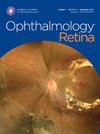Internal Limiting Membrane Peeling for Large Macular Holes Induces Only Structural Remodeling without Functional Impairment Over 12 Years
IF 5.7
Q1 OPHTHALMOLOGY
引用次数: 0
Abstract
Purpose
To evaluate the very long-term functional and structural outcomes of internal limiting membrane (ILM) peeling for full-thickness macular holes (FTMH).
Design
Observational case series nested within a multicenter, randomized, controlled clinical trial (RCT) (ClinicalTrials.gov: NCT00190190).
Subjects
Patients who underwent vitrectomy with or without ILM peeling for an idiopathic large FTMH in a tertiary ophthalmology center, with a minimum follow-up of 10 years after surgery.
Methods
Review of charts, spectral-domain OCT (SD-OCT) scans, OCT angiography (OCTA) scans, and microperimetry of patients originally enrolled in the RCT.
Main Outcome Measures
Primary outcome was functional assessment in both groups (ILM peeling or not) including the retinal sensitivity (RS), distance and near best-corrected visual acuity (BCVA), and number of eyes achieving ≥0.3 logarithm of the minimum angle of resolution >10 years after surgery. Secondary outcomes were structural assessment in the entire 3 × 3-mm and 6 × 6-mm areas, and regionally in the different areas of the ETDRS grid: OCT and OCTA biomarkers in both groups and fellow eyes.
Results
Thirteen eyes of 13 patients with a mean follow-up of 12 ± 0.73 years were included. The mean RS and BCVA, or visual improvement did not differ between ILM peeling (n = 8) and no peeling (n = 5) (all P > 0.05). The dissociated optic nerve fiber layers on en face OCT were only observed in eyes with ILM peeling, predominantly in temporal parafoveal (20%) and perifoveal (19%) rings. The mean total retinal thickness and inner retinal thickness in the parafoveal ring were significantly lower in peeled eyes (309 ± 11 μm and 94 ± 9 μm respectively) versus nonpeeled eyes (330 ± 21 μm and 108 ± 11 μm respectively; P = 0.037 and P = 0.040), without significant difference in ganglion cell or retinal nerve fiber layers. Accordingly, the mean superficial capillary plexus density in the parafoveal ring was significantly lower in eyes with peeling versus without (39.65 ± 3.76% versus 47.22 ± 4.00; P = 0.005). The mean foveal avascular zone area was smaller in eyes with peeling versus without (0.24 ± 0.05 mm2 vs. 0.42 ± 0.13 mm2, respectively, P = 0.005).
Conclusions
Despite persistent structural changes especially in the parafoveal ring, ILM peeling for idiopathic large FTMH did not seem to impact long-term RS or BCVA over 12 years.
Financial Disclosure(s)
Proprietary or commercial disclosure may be found in the Footnotes and Disclosures at the end of this article.
黄斑大孔内缘膜剥离术在 12 年内只会引起结构重塑,而不会造成功能损害。
目的:评估全厚黄斑孔(FTMH)内限膜(ILM)剥离术的长期功能和结构效果:观察性病例系列嵌套在一项多中心、随机对照临床试验(RCT)(ClinicalTrials.gov:NCT00190190)中:受试者:在一家三级眼科中心接受玻璃体切除术并进行或不进行ILM剥离以治疗特发性大面积FTMH的患者,术后至少随访10年:主要结果测量:主要结果是两组患者(ILM剥离与否)的功能评估,包括视网膜灵敏度(RS)、远近最佳矫正视力(BCVA)、术后10年以上视力≥0.3 logMAR的眼数。次要结果是整个 3x3mm 和 6x6mm 区域的结构评估,以及 ETDRS 网格不同区域的结构评估:结果:共纳入13名患者的13只眼睛,平均随访时间为(12 ± 0.73)年。ILM剥离组(8 例)和未剥离组(5 例)的平均RS、BCVA 或视力改善程度没有差异(均 p>0.05)。只有在进行了ILM剥离的眼球中才能观察到面内OCT上分离的视神经纤维层,主要分布在颞侧视网膜旁(20%)和视网膜周围(19%)环。与未剥离眼(分别为 330 ±21 μm 和 108 ±11 μm;p=0.037 和 p=0.040)相比,剥离眼的平均视网膜总厚度和视网膜旁环的视网膜内层厚度明显较低(分别为 309 ±11 μm 和 94 ±9 μm),而神经节细胞层或视网膜神经纤维层无明显差异。相应地,视网膜旁环的平均毛细血管丛密度在去皮眼与未去皮眼中明显较低(39.65 ±3.76 % 与 47.22 ±4.00; p=0.005)。结论:尽管存在持续的结构变化,尤其是在视网膜旁环,但对特发性大面积 FTMH 进行 ILM 剥离似乎不会影响 12 年的长期 RS 或 BCVA。
本文章由计算机程序翻译,如有差异,请以英文原文为准。
求助全文
约1分钟内获得全文
求助全文

 求助内容:
求助内容: 应助结果提醒方式:
应助结果提醒方式:


